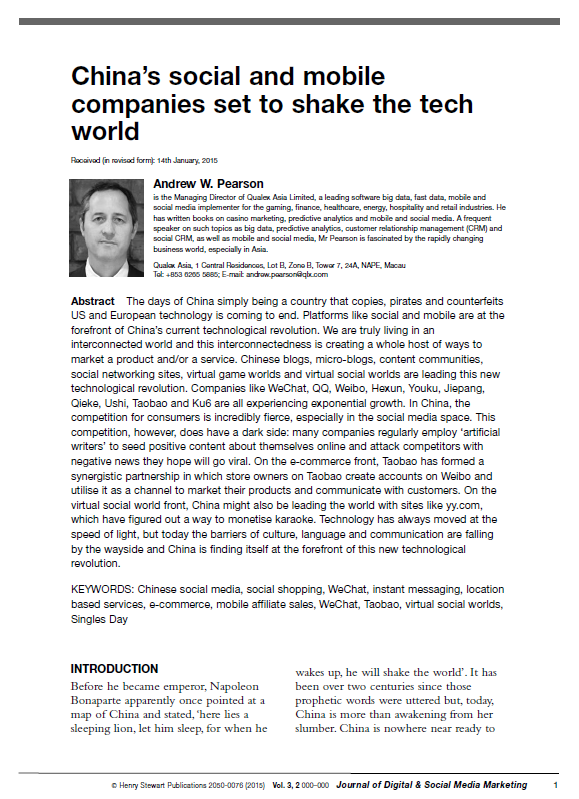Journal articles

Abstract: Today, the average campaign response rate is less than 1 percent and with the emergence of artificial intelligence (AI), traditional marketing is wading into troubled waters because the waves of strategic campaigns, the retargeting, the real-time media buying, and personalized emailing are not moving the marketing needle as they used to. The robotization of shopping and marketing is changing how brands compete for consumers. The real opportunity in marketing today lies in redefining the customer relationship rather than in cutting costs. In the future, humans might only be needed in the consumption phase of the buying cycle and purchasing decisions could be left to IoT-connected bots that order products for the customer. These products will then be delivered by anticipatory systems that understand when orders are to be made. For companies to succeed in this environment they need to make the marketing, ordering, and delivering process as seamless as possible, not just for the humans who will consume the products but also for the bots who will order them.

Abstract: We seem to be living in the age of AI. Everywhere you look, companies are touting their most recent AI, machine learning (ML), and deep learning breakthroughs, even when they are far short of anything that could be dubbed a breakthrough. Unfortunately, this excitement can’t always be translated into quantifiable success; only 1-in-3 AI projects are successful, and it takes more than 6 months to go from concept to production. These odds might be low, but the payoff can be huge and well worth the cost. It is imperative for companies to have both a single view of the customer as well as a single view of their media.

Abstract: The ancient Greeks invented the concept of the muse goddess to be a vessel that would enter a human’s life and spark long-desired creativity. The Greek gods didn’t want to give humans credit for coming up with creativity, humans may have invented something as good as a muse – artificial intelligence. Today, AI, machine learning, deep learning, and natural language processing, could be taking up that muse role as well as becoming the workhorse for many an artist’s grunge and possibly even creative work.
Anantrasirichai and Bull separate creative AI technologies into five groups, (i) content creation, (ii) information analysis, (iii) content enhancement and postproduction workflows, (iv) information extraction and enhancement, and (v) data compression. Services like DALL-E and MidJourney offer users the ability to create images in ways never before possible.

Abstract: The days of China simply being a country that copies, pirates and counterfeits US and European technology is coming to end. Platforms like social and mobile are at the forefront of China’s current technological revolution. We are truly living in an interconnected world and this interconnectedness is creating a whole host of ways to market a product and/or a service. Chinese blogs, micro-blogs, content communities, social networking sites, virtual game worlds and virtual social worlds are leading this new technological revolution. Companies like WeChat, QQ, Weibo, Hexun, Youku, Jiepang, Qieke, Ushi, Taobao and Ku6 are all experiencing exponential growth. In China, the competition for consumers is incredibly fierce, especially in the social media space. This competition, however, does have a dark side: many companies regularly employ ‘artificial writers’ to seed positive content about themselves online and attack competitors with negative news they hope will go viral. them.

Abstract: In 1999, ’The Cluetrain Manifesto’ warned that ‘markets are conversations’. Finally, some 15 years later, software, hardware, mobile and social media vendors have come together to provide tools that allow companies to join and manipulate the conversation. This paper provides a quick overview of the available hardware and software solutions; a discussion of the in-memory landscape, including the strengths and weaknesses of the competing products; and a summary of the latest developments in the social media monitoring space. Given the importance of personalisation and one-to-one advertising for increasing traffic, raising customer conversion rates and increasing average order value, these systems can either be a company’s best friend or its worst enemy.

Abstract: Capacity planning or capacity management is the process of determining the production needed by an organization to meet changing demands for its products and services. For marketing departments, the key to capacity management is to counterbalance the right number of users and the right performance at peak usage to ensure a great end-user experience. Rather than waiting for a dream solution to materialize, marketers need to find a system that enables them to make better decisions and support those decisions with verifiable data.
The Flexera 2020 State of the Cloud Report showed that organizations were wasting 30 percent of their cloud spend. IT capacity planning, which involves estimating the storage, computer hardware, software, and connection infrastructure resources required over some future period of time, should be able to help reduce wasted capacity. A common concern of enterprises is whether the required resources are in place to handle an increase in users or the number of interactions.